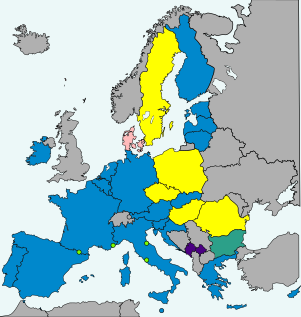
- European Union member states (special territories not shown)
- 20 in the eurozone1 in ERM II, with an opt-out (Denmark)5 not in ERM II, but obliged to join the eurozone on meeting the convergence criteria (Czech Republic, Hungary, Poland, Romania, and Sweden)
- Non–EU member states
Croatia adopted the euro as its currency on 1 January 2023, becoming the 20th member state of the eurozone. A fixed conversion rate was set at 1 € = 7.5345 kn.[1]
Croatia's previous currency, the kuna, used the euro (and prior to that one of the euro's major predecessors, the German mark or Deutsche Mark) as its main reference since its creation in 1994, and a long-held policy of the Croatian National Bank was to keep the kuna's exchange rate with the euro within a relatively stable range.[2]
Croatia's European Union (EU) membership obliged it to introduce the euro once it had fulfilled the euro convergence criteria.[3] Prior to Croatian entry to the EU on 1 July 2013, Boris Vujčić, governor of the Croatian National Bank, stated that he would like the kuna to be replaced by the euro as soon as possible after accession.[4] This had to be at least two years after Croatia joined the European Exchange Rate Mechanism (ERM II), in addition to it meeting other criteria. Croatia joined ERM II on 10 July 2020.[5] Prime Minister Andrej Plenković stated in November 2020 that Croatia intended to adopt the euro on 1 January 2023,[6] and in December 2020 the Croatian government adopted an action plan for euro adoption.[7]
Many small businesses in Croatia had debts denominated in euros before EU accession.[8] Croatians already used the euro for most savings and many informal transactions. Real estate, motor vehicle and accommodation prices were mostly quoted in euros.
On 18 July 2022, the Croatian Mint began producing euro coins with Croatian national motifs.[9][10][11]
- ^ "Croatia set to join the euro area on 1 January 2023: Council adopts final required legal acts". Europa. Archived from the original on 25 July 2022. Retrieved 13 July 2022.
- ^ "EFFECTIVENESS OF FOREIGN EXCHANGE INTERVENTION IN CROATIA" (PDF). Archived (PDF) from the original on 3 January 2023. Retrieved 3 January 2023.
- ^ "Joining the euro area". Council of the EU and the European Council. General Secretariat of the Council. Archived from the original on 18 March 2023. Retrieved 24 July 2021.
- ^ THOMSON, AINSLEY (4 June 2013). "Croatia Aims for Speedy Adoption of Euro". The Wall Street Journal. New York. Archived from the original on 21 January 2016. Retrieved 7 September 2013.
- ^ "Communiqué on Croatia" (Press release). European Central Bank. 10 July 2020. Archived from the original on 18 April 2021. Retrieved 11 July 2020.
- ^ "Croatia eyes euro adoption in 2023 -PM". Reuters. 11 November 2020. Archived from the original on 1 January 2023. Retrieved 9 June 2021.
- ^ "Croatia adopts plan for replacing kuna by euro to protect consumer rights". SeeNews. 23 December 2020. Archived from the original on 4 January 2023. Retrieved 9 June 2021.
- ^ Joy, Oliver (21 January 2013). "Did Croatia get lucky on EU membership?". CNN. Archived from the original on 30 April 2021. Retrieved 24 June 2013.
- ^ "Početak proizvodnje hrvatskih eurokovanica". croatianmint.hr (in Croatian). Hrvatska kovnica novca. 18 July 2022. Archived from the original on 30 November 2022. Retrieved 2 August 2022.
- ^ "Počela proizvodnja hrvatskih eurokovanica, kao dio eurozone bit ćemo zaštićeniji u nošenju s izazovima". vlada.gov.hr (in Croatian). Government of Croatia. 18 July 2022. Archived from the original on 18 March 2023. Retrieved 2 August 2022.
- ^ "È iniziato il conio delle monete di euro croate". La Voce del Popolo (in Italian). 18 July 2022. Archived from the original on 2 October 2022. Retrieved 2 August 2022.